Content for TS 23.434 Word version: 19.3.0
0…
4…
5
6…
6.4…
6.5…
6.5.3…
7…
8…
8.2.2…
9…
9.3…
9.3.2.21…
9.3.3…
9.3.6…
9.3.11…
9.3.13…
9.3.14…
9.4…
9.4.6…
9.5…
10…
10.3…
10.3.2.22…
10.3.3…
10.3.7…
10.3.10…
10.4…
11…
11.3…
11.3.3…
11.4…
12…
12.3…
13…
14…
14.2.2.2…
14.3…
14.3.2.20…
14.3.2.40…
14.3.3…
14.3.3.3…
14.3.4…
14.3.4.6
14.3.4.7…
14.3.4A…
14.3.4A.3…
14.3.4A.4…
14.3.4A.6…
14.3.4A.8…
14.3.4A.9…
14.3.4A.10…
14.3.5…
14.3.6…
14.3.9…
14.3.12…
14.4…
15…
16…
17…
18…
A
B…
9.3.14 Location profiling for supporting location service enablement
9.3.14.1 Location profiling
9.3.14.2 Procedure of Location profiling for location service
9.3.15 Location service registration procedure
9.3.16 Location information unsubscribe procedure
9.3.17 Monitor location unsubscribe procedure
9.3.18 Location service registration update procedure
9.3.19 Location service deregistration procedure
9.3.20 SEAL location management server provides adaptive configuration
9.3.21 Location history querying procedure
9.3.22 Surrounding UEs retrieval procedure
...
...
9.3.14 Location profiling for supporting location service enablement |R18| p. 92
9.3.14.1 Location profiling p. 92
The location management server enhanced with the Fuse Location Function(FLF) supports the creation of location profiles for location service at the application enablement layer and the mapping of location profiles to one or more vertical applications. Location profiling is based on the vertical driven hybrid positioning requirements and policies.
The example of attributes that can be used for the location profiles is specified in Annex D.
9.3.14.2 Procedure of Location profiling for location service p. 92
The procedure includes the translation of the vertical request to a location profile and the derivation of the requested location information report.
Pre-condition:
The Location Management Server has configured a set of location service profiles.
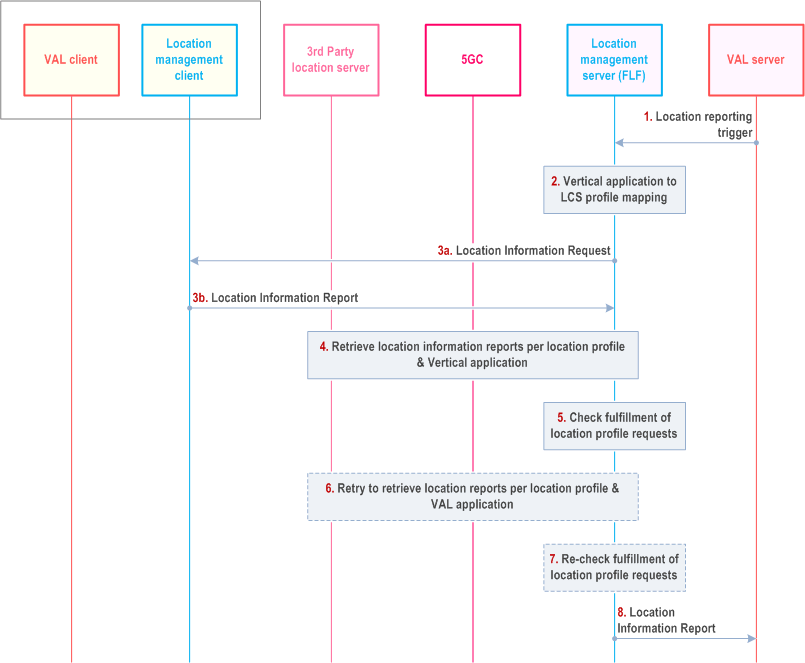
Step 1.
The LM Server receives a location reporting trigger from VAL server and activates a location reporting procedure as defined in clause 9.3.5.
Step 2.
The Fused Location Function determines a mapping of the vertical location services to a location service profile based on the location request information, the location profiles and the location capability of VAL UE which registered to the LM Server before.
Step 3a.
The LM Server requests from the LMC the location information of the target VAL UE optionally with the requested location information (the access type, positioning method) based on the determined location profiles in LM server obtained in step 2.
Step 3b.
The LM Client responds to the LM Server the location report based on the request.
Step 4.
The LM Server performs a location information request to one or more of the following (based on the location profile):
Step 5.
- to GMLC directly or via NEF (as defined in TS 23.273), acting as AF.
- to 3rd party location servers.
The Fused Location Function calculates the location information based on combined location reports from step 3~4 and checks whether the location reports fulfil the location profile requirements.
Step 6-7.
If the requirements are not fulfilled, the LM Server will repeat the step 3~5 iteratively to request location information and re-check whether the requirements are met or not.
Step 8.
If the requirements are fulfilled, the LM Server sends the location information report to the VAL server.
9.3.15 Location service registration procedure |R18| p. 94
Before the Location Management Server requesting the location information for the target UE, the Location Management Client may register the available location services to the LM Server to report the UE's location capabilities.
Figure 9.3.15-1 illustrates the procedure of client-triggered location service registration.
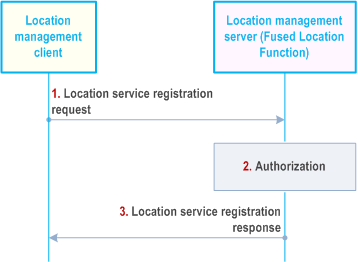
Step 1.
The LM Client of a VAL UE sends location service registration request to the LM Server, with the identifier of the UE (e.g. GPSI) and UE-based location capabilities.
Step 2.
The LM Server checks authorization for the VAL UE's registration request.
Step 3.
After successful authorization, LM Server sends location service registration response to the LM Client and stores the UE identifier information and location capabilities.
9.3.16 Location information unsubscribe procedure |R18| p. 94
Figure 9.3.16-1 illustrates the high level procedure of location information unsubscribe request. The same procedure can be applied for the location management client and other entities that would like to unsubscribe to the VAL UE's location information.
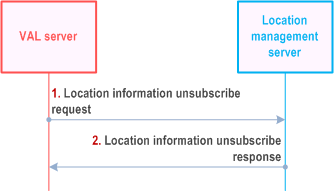
Step 1.
The VAL server sends location information unsubscribe request to the location management server to unsubscribe the subscription to the VAL UE's location information.
Step 2.
The location management server replies with location information unsubscribe response indicating the unsubscribe status.
9.3.17 Monitor location unsubscribe procedure |R18| p. 95
Figure 9.3.17-1 illustrates the high level procedure of location monitoring unsubscribe request. The same procedure can be applied for other entities that would like to unsubscribe the subscription to monitor the VAL UE's location in a given area of interest.
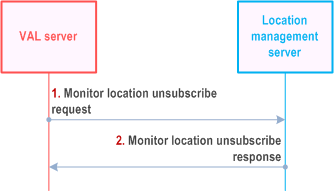
Step 1.
The VAL server sends Monitor location unsubscribe request to the location management server to unsubscribe the subscription to monitor the VAL UE's location in a given area of interest.
Step 2.
The location management server replies with Monitor location unsubscribe response indicating the unsubscribe status.
9.3.18 Location service registration update procedure |R18| p. 95
Figure 9.3.18-1 illustrates the procedure of client-triggered location service registration update. The Location Management Client may update its supported location capabilities (e.g. location access type, position methods) which has registered to the Location Management Server before.
Pre-condition:
The Location Management Client has registered to the Location Management Server.
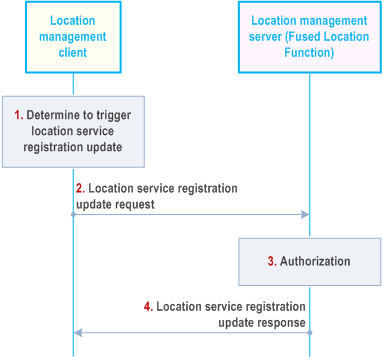
Step 1.
The LM Client decides to trigger the registration update request to LM Server to update the location capabilities which have registered to the LM Server before.
Step 2.
The LM Client sends location service registration update request to the LM Server with the identifier of the VAL UE, the VAL service ID and updated location capabilities.
Step 3.
The LM server checks the authorization for the VAL UE's registration update request. If the authorization is successful, the LM server will update the UE's location capabilities received in step 2.
Step 4.
The LM Server sends location service registration update response to the LM Client.
9.3.19 Location service deregistration procedure |R18| p. 96
Figure 9.3.19-1 illustrates the procedure of client-triggered location service deregistration. By deresgistration, the Location Management Client may deregister the available location services which have registered to the Location Management Server before.
Pre-condition:
The Location Management Client has registered to the Location Management Server.
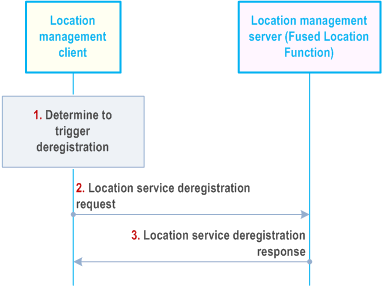
Step 1.
The LM Client decides to trigger the deresgistration request to LM Server to deregister the location services which have registered to the LM Server before.
Step 2.
The LM Client sends location service deregistration request to the LM Server with the identifier of the UE.
Step 3.
The LM Server sends location service deregistration response to the LM Client and removes all registration information of the UE.
9.3.20 SEAL location management server provides adaptive configuration |R19| p. 97
Figure 9.3.20-1 illustrates procedure for SEAL LMS to provide adaptive location configuration suggestion to the VAL server for the VAL UE for which VAL server has requested for adaptive reporting (as specified in clause 9.3.5).
Pre-conditions:
- The VAL server has requested to SEAL LMS to suggest adaptive configuration for VAL UE;
- The VAL server has provided endpoint information in the Location reporting trigger to the SEAL LMS.
- The SEAL LMS has received location reports from SEAL client and based on the different information the SEAL LMS as determined the new/adaptive location configuration.
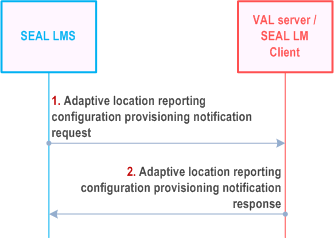
Step 1.
The SEAL LMS sends a message to the VAL server (or authorized SEAL LM client). The message includes UE identity and suggested updates for location reporting trigger configuration.
Step 2.
Upon receiving the request from the SEAL LMS, the VAL server (or authorized SEAL LM client) sends a response message. The response message includes whether the VAL server accepts or rejects the updated location reporting configuration suggestion or not. If the VAL server accepts the location reporting configuration as suggested by the SEAL LMS, then the SEAL LMS updates the location reporting configuration to the SEAL LM client of the target UE.
9.3.21 Location history querying procedure |R19| p. 97
9.3.21.1 Location tracing configuration create procedure p. 97
Figure 9.3.21.1-1 illustrates the high level procedure of creating location tracing configuration from VAL server to the LM server.
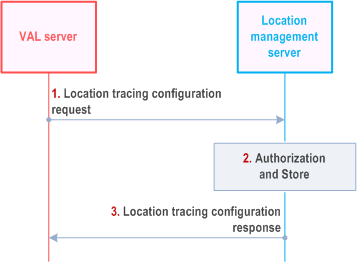
Step 1.
The VAL server sends a location tracing configuration request to the LM server to configure the location tracing service in advance. The location tracing configuration request may contain the geographical area for history location tracing, events/conditions for triggering the location history report, location QoS, the identities for the UE and service, the time till when the SEAL LM needs to store the location history data and the required positioning method(s) , etc.
Step 2.
The LM server checks whether the VAL server is authorized to request the location tracing configuration service. If the request is approved, the LM server stores the configuration received in step 1. If the request includes multiple UEs, the LM server creates and stores the contexts for each UE.
Step 3.
The LM server sends the location tracing configuration responses to the VAL server.
9.3.21.2 Location history request procedure p. 98
Figure 9.3.21.2-1 illustrates the high level procedure of location history request which the VAL server triggers to query the history location data for some specific UEs in some specific conditions.
Pre-conditions:
- The location management server has obtained the UE location data from multiple sources as defined in clause 9.3.3 and clause 9.3.5 periodically based on the event triggers or conditions received in the request of step 1 in clause 9.3.21.1.
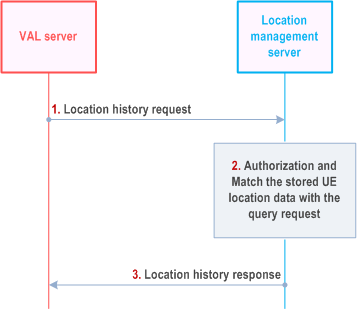
Step 1.
The VAL server sends a location history request to the LM server with the specific conditions (e.g. the given location area, time/period, etc.) to query the history location data for a single UE or multiple UEs.
Step 2.
The LM server checks the authorization for the request. If the request is authorized, the LM server matches the obtained UE location data with the location history request. Before the match, the LM server may transform the obtained UE location data into the same format of the location area information received in step 1 if needed.
Step 3.
The LM server sends a location history response to the VAL server with the matched UE location information. If there is no matched UE location data, the failure reason can be included.
9.3.21.3 Location tracing configuration cancel procedure p. 99
Figure 9.3.21.3-1 illustrates the high level procedure of location tracing configuration cancel request which the VAL server triggers to cancel the location tracing configuration for a single UE or multiple UEs.
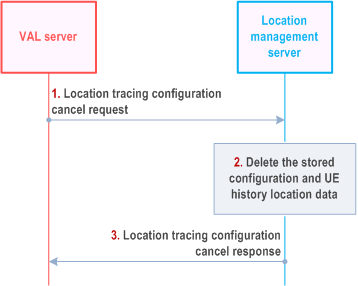
Step 1.
If the VAL server decides to stop the location tracing services for the UE(s), it sends a location tracing configuration cancel request to the LM server with the UE identities.
Step 2.
The LM server stops getting the UE's location and deletes the stored UE location data and the location tracing configuration for the service.
Step 3.
The LM server sends location tracing configuration cancel response to the VAL server.
9.3.22 Surrounding UEs retrieval procedure |R19| p. 100
Figure 9.3.22-1 illustrates the procedure of surrounding UE(s) retrieval. The LM server can use this procedure to know how many UE(s) are close to the requested UE hosting the LM client, and their identities.
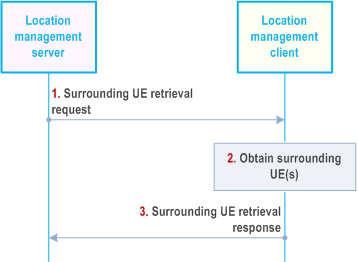
Step 1.
The LM server decides to Surrounding UE retrieval request to the LM client. The request may include surrounding UE retrieval method.
Step 2.
The LM client obtains UE(s) close to itself. The LM client considers the surrounding UE retrieval method (if received) during the obtaining procedure.
Step 3.
The LM client sends its surrounding UE(s) to the LM server in Surrouding UE retrieval response.